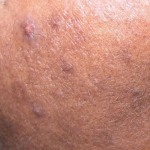VIDEO (http://www.acne.com/types-of-acne/what-causes-adult-acne/)
But this sloughing process is different for everyone. You might shed cells evenly – or not. Uneven shedding causes dead cells to become sticky, clumping together to form a plug – much like a cork in a bottle. This plug, or comedo, traps oil and bacteria inside the follicle.
Here are some of the main culprits known to cause acne:
- Hormonal Imbalance / Menstrual Abnormalities
- Extra sebum (Oil Production by sebaceous glands present on face)
- Follicle fallout
- Bacteria (bacterium Propionibacterium acnes) see video
- Inflammation
TYPES OF ACNE
White & Black Heads : When the pores of your skin accumulate oils or sebum, you get whiteheads. The reason these lesions turn into whiteheads (versus blackheads) is because the clogged areas are not exposed to air. (With blackheads, air causes oxidation, and that oxidation darkens the tips of clogged areas.)
Papules: Papules are small, firm cone-shaped bumps that are pink in color. It’s
basically a fancy name for an inflamed whitehead. That’s why they’re
tender to touch unlike other forms of acne. Not to be gross,

but
they contain no pus. Since they don’t contain pus you should never pop
or poke them. If you do you might seriously irritate your skin and
aggravate your existing pimples – and possibly end up with a permanent
scar – with zero effect on the papules themselves.
Pustules:Like papules, pustules are small, round lesions. You’ll notice
they’re red in color with yellowish or whitish centers (caused by
visible pus). While inflamed, pustules are generally painless and do not
contain a great deal of bacteria. The inflammation is actually the
result of a chemical irritation from things like free fatty acids, which
are substances that circulate in the bloodstream and are common in
everyone’s skin, although it’s possible there are other causes.
While it may be tempting to pop a pustule – don’t do it. You could
end up with a permanent scar. If you got one that’s particularly
bothersome, see your dermatologist to have it expressed properly.
Nodules & Cysts:
Nodular acne appears in large areas of your skin and is usually very
painful. What’s the root of all this?
Nodules are severely inflamed, hard lesions lodged deep within the skin.
Cysts, while similar, are softer, pus-filled lesions, also deep under
the skin. They develop when the contents of your comedones (a medical
term for whiteheads or blackheads) have spilled into the surrounding
areas.
Unlike other forms of acne, nodules may persist for weeks or even
months, the result of their contents hardening into deep (and stubborn)
cysts.
 ,
,
Cystic acne is the most serious type of skin acne although nodules do not always develop into cysts. Both cysts and
nodules, although similar, can exist independently as either nodular or
cystic acne. They occur together, too, as nodularcystic (or
nodulocystic) acne. Left untreated, they are likely to cause scarring,
so if you think you have this condition, you should see a dermatologist
for treatment.
Like most acne, nodular and cystic outbreaks can affect anyone but
are more common in teenage boys and young men. Unfortunately, these
types of acne often have genetic causes-if one or both of your parents
had such outbreaks there is a good chance you’ll have them, too.
Back Acne: Back acne is triggered when heat and sweat is trapped against
the body, and when your skin is irritated by friction.
Acne Conglobata: Acne conglobata (AC) is severe form of acne that
can affect your back, buttocks, chest, shoulders, upper arms, thighs,
and even your face. AC is characterized by abscesses and scars.
Medically speaking, this condition is essentially a combination of acne
pustules and nodules, though you might have bacterial infections as
well.
AC affects younger male adults more than females,
This is a medical condition, obviously a physically and emotionally
destructive one, so if you think you have AC, see a dermatologist as
soon as possible.